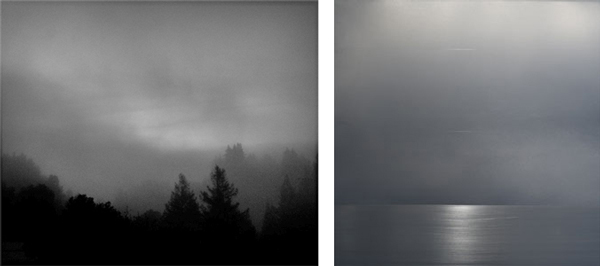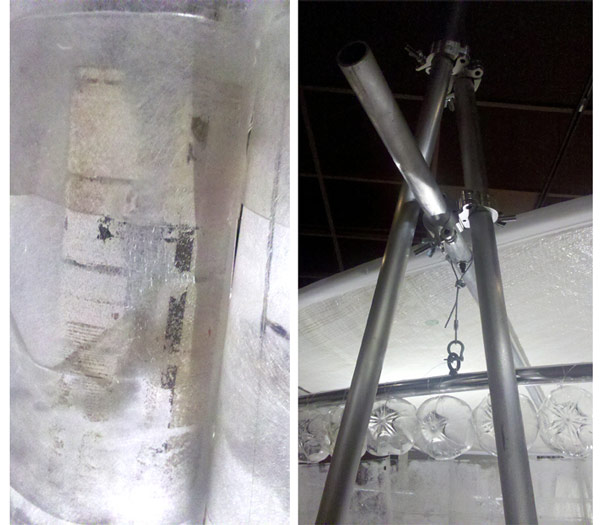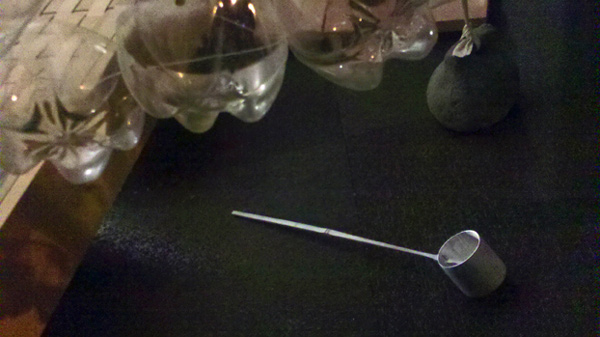“With swordmaking in Japan, you wear all white, you cleanse your soul and purify yourself. The transferral of the energy goes directly into this object. On the handle of the sword are these Buddhist prayers and Buddhist deities. The sword only has one function, and it’s a violent function, but the creating of the object is done with this reverence.”
This quote from Miya Ando carries all the strength of contradiction that made last Friday’s Butoh and poetry performance at ArtXchange riveting and unforgettable. Entering the gallery, I was drawn immediately to the main room where Ando’s paintings in cast metal hung on the walls in stately sequence. They invited what I would describe as serene shock: the body knows it is confronting hard, cold metal, and yet the eye falls into thin air, cloudspace, the sumi-black forests of Bolinas. From panel to panel the delicate atmospheric grays of photography alternated with pure abstraction to arrive at complete, resolute stillness. The surfaces had been etched, burnished, sanded, dipped in resin, mysteriously transformed by human handcraft into something beyond human. The rigor and discipline of these pieces reflect Ando’s childhood, growing up in a temple in Japan, in a family with a long tradition in the art of sword-making.

Above them and throughout the gallery, shimmering kimonos drifted suspended from the ceiling. Visiting Santa Fe poet Piper Leigh creates these kimonos from pale silk and embeds words and images in the translucent fabric. For this evening she collaborated with Butoh artist Jyl Brewer (Shinjo), and two musicians to create a performance piece that traveled through the gallery and into the teahouse designed by architect Chris Ezzell.
The performance began with readings from Leigh’s new book of poetry and photographs, “my thin-skinned wandering,” just out from Tres Chicas Books. This title phrase, taken from the first poem, “A Dilemma of Transparency,” seemed particularly apt for the dance of Butoh, with its barely shielded body and the self made so vulnerable: shimmering and half-hidden, cloaked, clothed, naked without and within.
(Photos, Piper Leigh)
The teahouse itself was a marvel, entirely constructed of recycled plastic bottles. From a distance it almost looked like what it was, but close up and illuminated the plastic became abstract, unnamable, perhaps white birch bark or alabaster.


(Photos, Iskra Johnson)
Much of the performance took place inside this translucent curtain, and I could only catch fragments. My mind drifted. White silk reflected in the stainless steel on the walls. Metal mixed with thread, shakuhachi became piano in a temple where I slept one night in Koyasan Japan, in monsoon season. I had awakened towards midnight, disturbed by wind and strange music. I slipped into the hall and downstairs I saw, cast on a white shoji screen, the shadows of a family gathered around a piano. My mind hovered there on the temple stairs and in the rainforests of Mt. Koya. I came back to this world only in glimpses, when the kimono flew through the air and shuddered for a moment above the smoking lamp.

I was completely taken with the entire evening, but especially with the depth of Piper Leigh’s sure and imagistic poetry. We met up later at The Panama Cafe and talked at length. Piper is not only a writer, but a photographer and a maker of books. She creates installations that take shape as mobiles, scrolls or kimonos or cloth. As founder and principle of Comunica, she is deeply involved with interactive learning design. She describes her work as committed to inspiring a “culture of connection,” of which the evening at ArtXchange was a wonderful example.